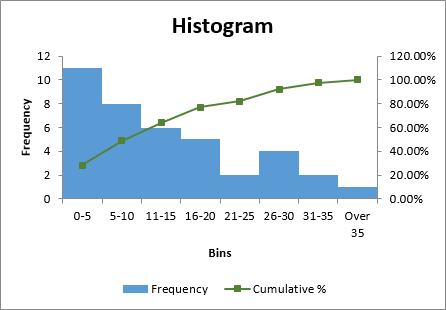

The output of the histogram analysis is displayed on a new worksheet (or in a new workbook) and shows a histogram table and a column chart that reflects the data in the histogram table. If you omit the bin range, Excel creates a set of evenly distributed bins between the minimum and maximum values of the input data.
#MAKE HISTOGRAM IN EXCEL 2016 HOW TO#
A data point is included in a particular bin if the number is greater than the lowest bound and equal to or less than the greatest bound for the data bin. Microsoft Excel 2016 introduced new chart types for exploring and quickly visualizing common financial, statistical, and hierarchical data. If that happens that you have been using one of the latest Excel by Microsoft & you want to learn how to analyze data in Excel then, here are the steps to be followed to generate the histogram for your data. On the Insert tab, in the Charts group, click the Statistic button: From the Statistic dropdown list, select Histogram: Excel creates the histogram chart from the data: As you can see, the default histogram has too many bins (bars), but you can change the.

When you use the Histogram tool, Excel counts the number of data points in each data bin. Select the prepared data (in this example, C2:D20 ). Input data This is the data that you want to analyze by using the Histogram tool.īin numbers These numbers represent the intervals that you want the Histogram tool to use for measuring the input data in the data analysis. These columns must contain the following data: You must organize the data in two columns on the worksheet. To create a histogram in Excel, you provide two types of data - the data that you want to analyze, and the bin numbers that represent the intervals by which you want to measure the frequency. If you used column labels on the worksheet, you can include them in the cell references. In the Bin Range box, enter the cell reference for the range that has the bin numbers. In the Input Range box, enter the cell reference for the data range that has the input numbers. To create a histogram using the Data Analysis Toolpak, you first need. Creating a Histogram using Data Analysis Toolpak. Excel 2016 has an inbuilt Histogram chart option. On the Insert tab, go to the Charts Group and click the Histogram symbol. To add a Histogram chart, follow these steps: Select the range of cells. If you don't enter any bin numbers, the Histogram tool will create evenly distributed bin intervals by using the minimum and maximum values in the input range as start and end points. How To Make a Histogram in Excel 2016 Creating a Histogram in Excel 2016. Excel 2016 has an inbuilt Histogram chart option.

It’s a good idea to use your own bin numbers because they may be more useful for your analysis. In the next column, type the bin numbers in ascending order, adding a label in the first cell if you want. The Histogram tool won’t work with qualitative numeric data, like identification numbers entered as text. On a worksheet, type the input data in one column, adding a label in the first cell if you want.īe sure to use quantitative numeric data, like item amounts or test scores. For more information, see Load the Analysis ToolPak in Excel. Make sure you have loaded the Analysis ToolPak.


 0 kommentar(er)
0 kommentar(er)
